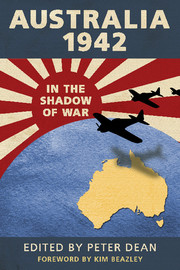Book contents
- Frontmatter
- Foreword
- Contents
- Photos
- Maps
- Charts
- Acknowledgements
- Contributors
- Abbreviations
- Maps
- Introduction
- Part 1 Australia in 1942
- Part 2 Relations, politics and the home front
- Chapter 2 World wars and the anticipation of conflict
- Chapter 3 The overlooked mission
- Chapter 4 The home front and the American presence in 1942
- Chapter 5 ‘Dangers and problems unprecedented and unpredictable’
- Part 3 Australia under threat
- Part 4 The war on Australia’s doorstep
- Index
- References
Chapter 4 - The home front and the American presence in 1942
from Part 2 - Relations, politics and the home front
Published online by Cambridge University Press: 05 January 2013
- Frontmatter
- Foreword
- Contents
- Photos
- Maps
- Charts
- Acknowledgements
- Contributors
- Abbreviations
- Maps
- Introduction
- Part 1 Australia in 1942
- Part 2 Relations, politics and the home front
- Chapter 2 World wars and the anticipation of conflict
- Chapter 3 The overlooked mission
- Chapter 4 The home front and the American presence in 1942
- Chapter 5 ‘Dangers and problems unprecedented and unpredictable’
- Part 3 Australia under threat
- Part 4 The war on Australia’s doorstep
- Index
- References
Summary
It was in the military context of early 1942 that the Australian government swiftly brought in comprehensive and far-reaching controls over all aspects of civilian life as a means of encouraging and enforcing an ‘all-in’ war effort and social unity across existing class, generational and political divisions. Although Australia had been at war since September 1939, with the 2nd AIF fighting in Europe and the Middle East, the home front had been geographically distant from the military theatre. With conflict now in Australia’s immediate region, the relatively new Labor government of Prime Minister John Curtin was faced with the task of meeting the expanding requirements for labour and production so as to protect Australia in its ‘darkest hour’.
This chapter outlines many of the changes on the Australian home front during 1942, as the nation experienced profound economic and social disruptions in a time of crisis. These upheavals included the unsettling of pre-war expectations about the role of Australian women in the workforce and domestic sphere, as the demands of war created new opportunities for women and publicly censured private behaviours deemed to be morally inappropriate. The ‘friendly invasion’ of thousands of US military personnel in Australia from 1942 until the end of the Second World War was to contribute to the aberrant and ‘topsy-turvy’ experiences of the Australian home front in ways that were often fleeting, but were also profound and long-lasting. Certainly, the bilateral relationships that developed between the two governments and on personal levels between the two peoples were to influence understandings of Australia’s national identity and its sense of place within its region and the wider world in the postwar decades.
- Type
- Chapter
- Information
- Australia 1942In the Shadow of War, pp. 70 - 88Publisher: Cambridge University PressPrint publication year: 2012

